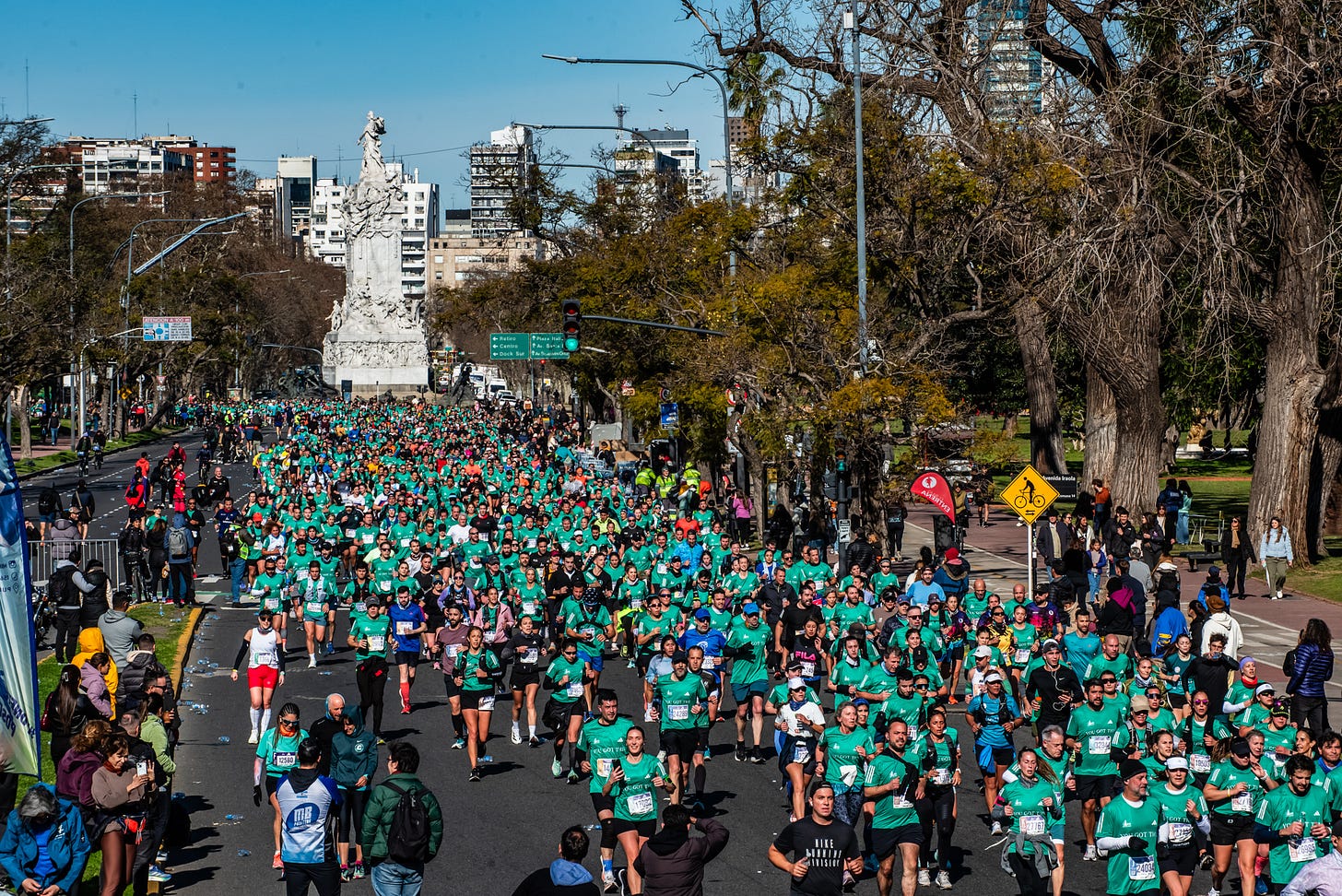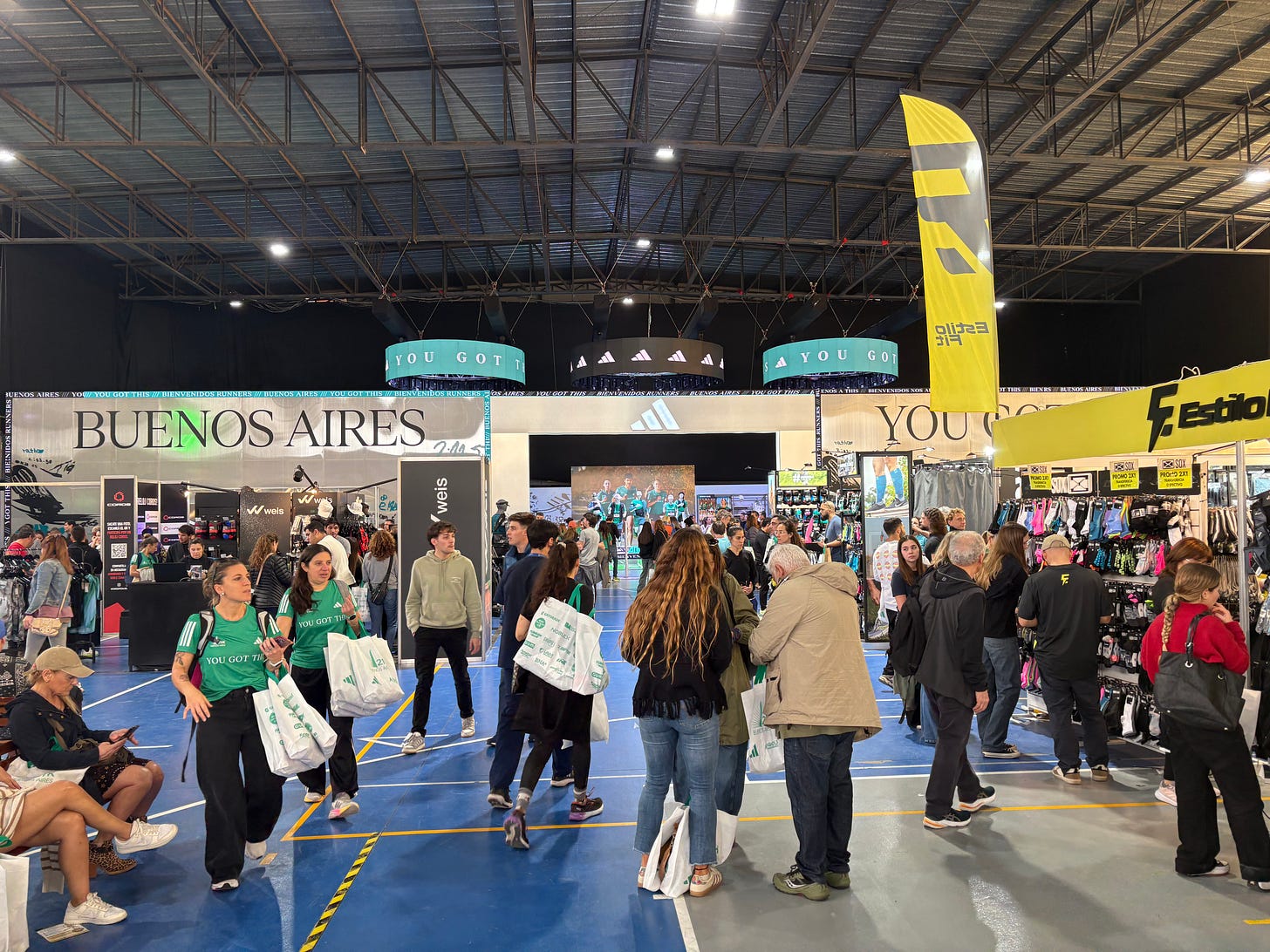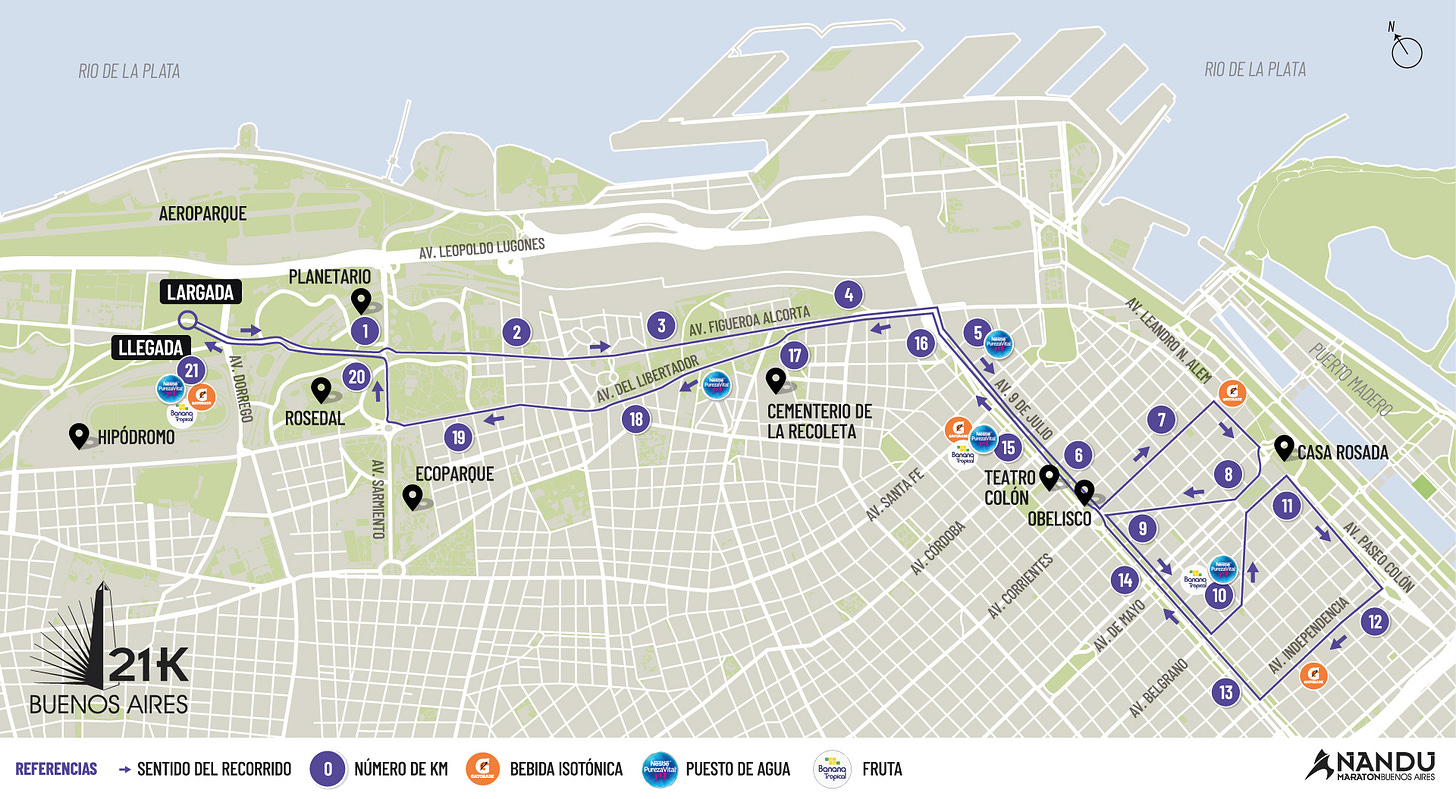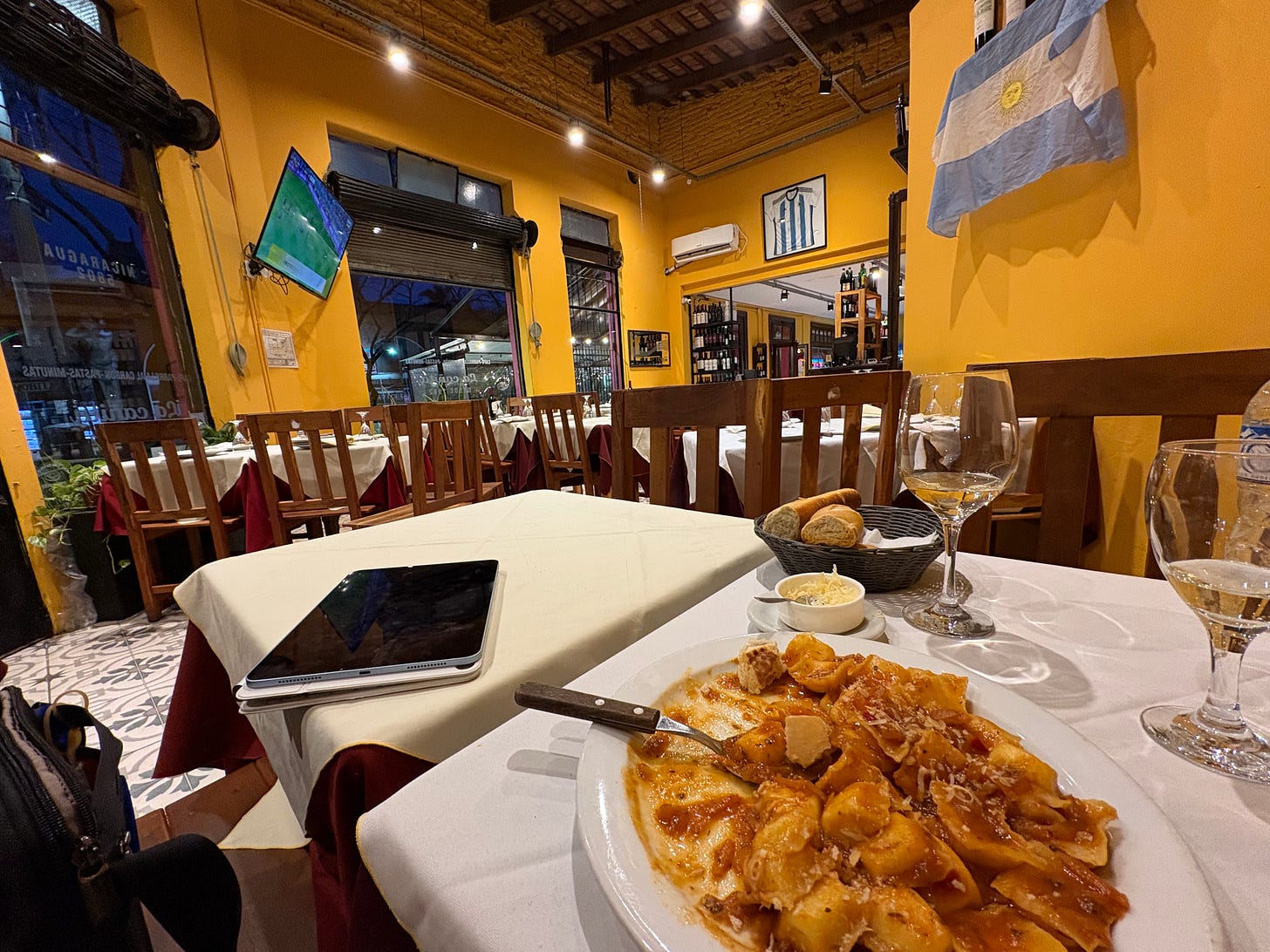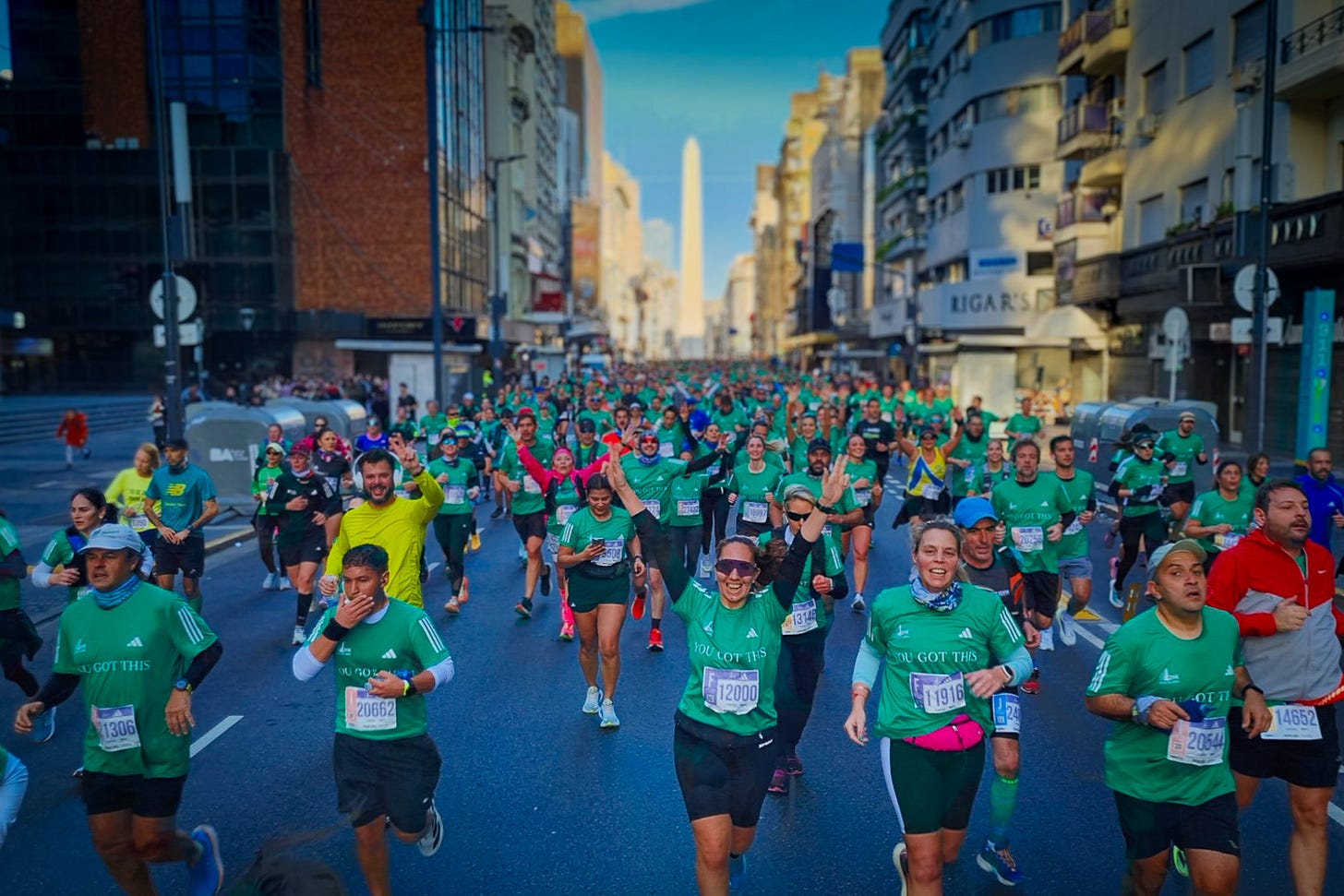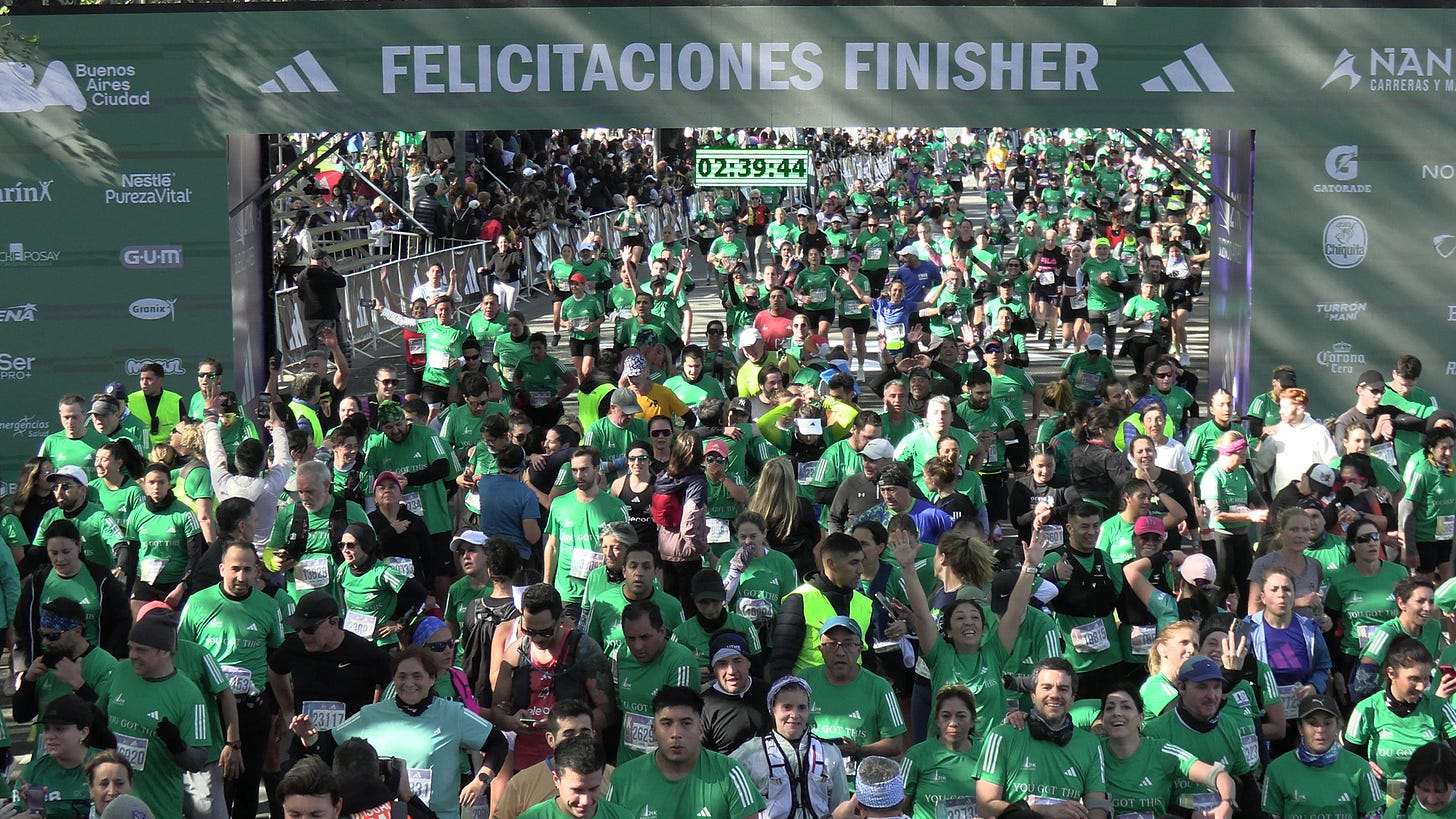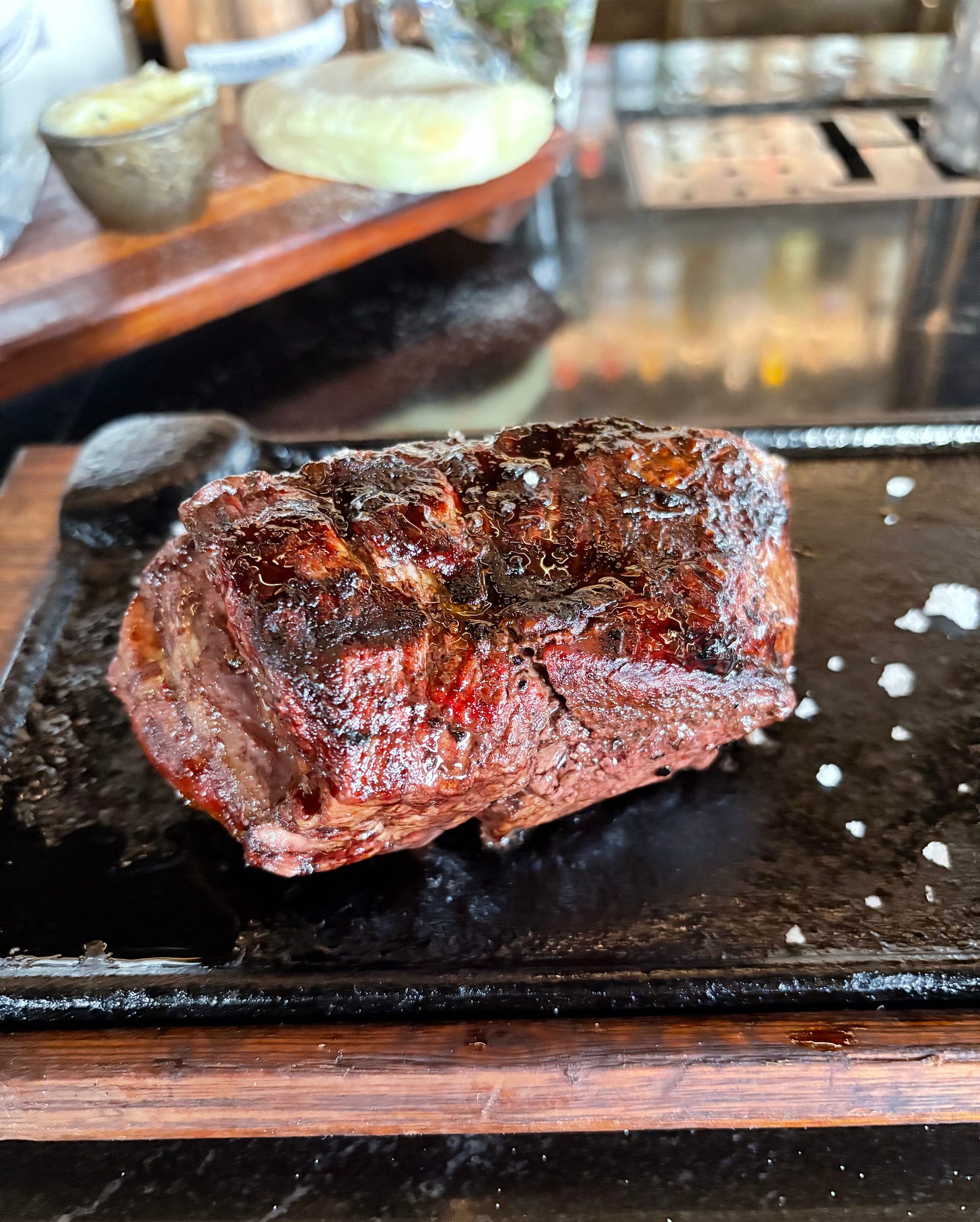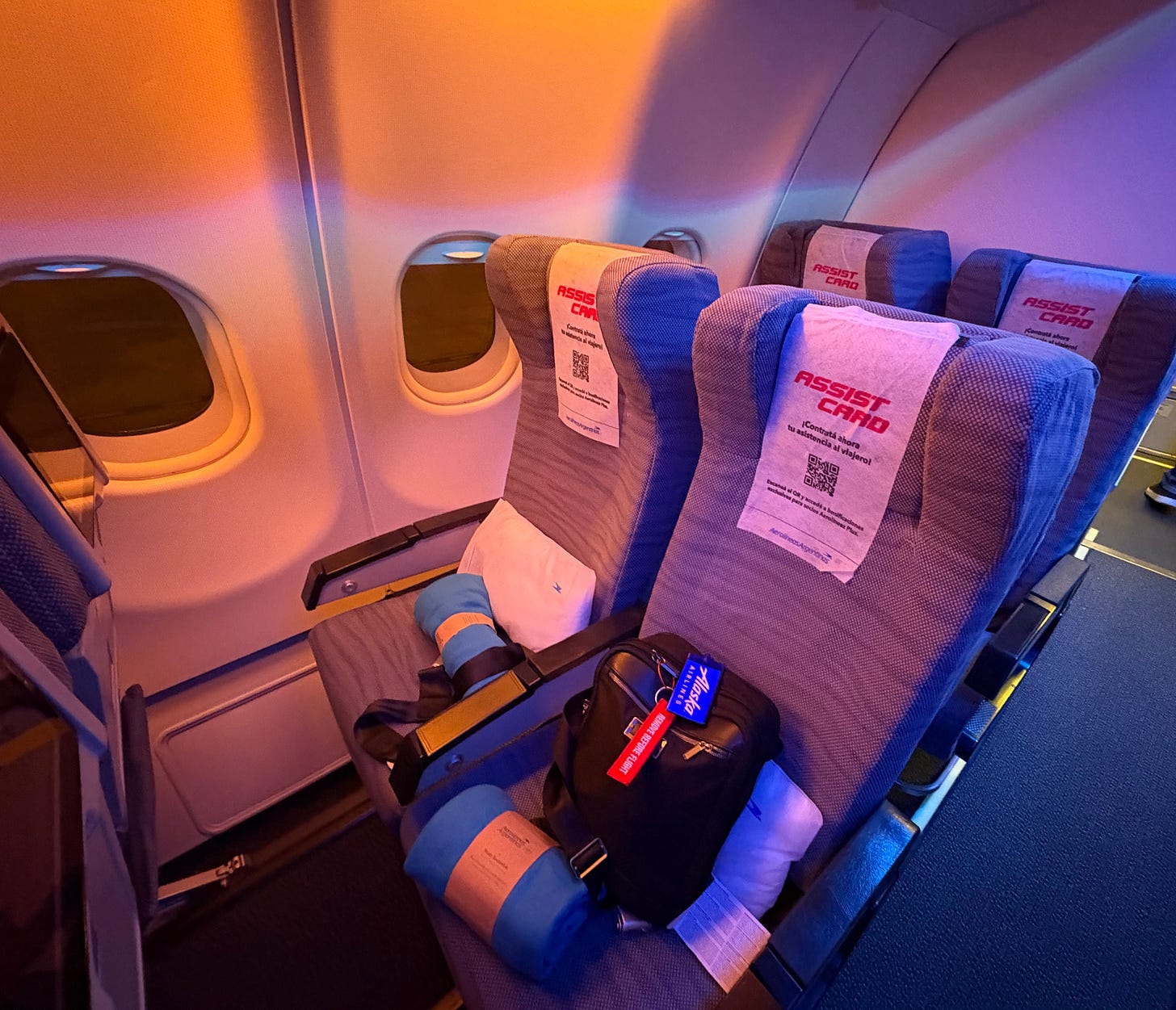Buenos Aires Half Marathon: 2025 race review and trip report
Plus: Why I like hop-on/hop-off buses. My fleeting connection with Margaret Thatcher. “Airline chicken.” And other travel and non-rev notes.
The Buenos Aires Half Marathon is one of South America’s largest road races. There are about 25,000 sign-ups. It is run every year in August, making it — like the Run Melbourne event about which I wrote recently — a good pick for northern hemisphere runners wanting to head into cooler winter temperatures at that time of year. It’s a single-distance event. However, the organizers also put on the city’s full marathon later in the year.
I ran the 2025 edition. This was my first-ever race in South America. And with this review, my flyrun blog has now — in its roughly three years of existence — covered races in all six inhabited continents. (There is a half and full marathon in Antarctica, but it costs $22,500 to enter, including private air travel from Chile and tented accommodations at the race location.)
Buenos Aires and the zen of hop-on/hop-off
Buenos Aires has probably the most European appearance and feel of any major city in South America. It is sometimes called the “Paris of South America” due to its architecture, grand boulevards, tree-lined streets, and metropolitan culture. While Spanish is the language, the city is heavily influenced by its history of Italian immigration.
This visit was very short. I got in early on the Friday before the Sunday race, and left the night of race day. So just two nights on the ground. I’d been there once before, albeit a long time ago — my wife and I went there as part of a South America trip in 1994 that was our last adventure together before having children.
Buenos Aires is not an especially walkable city. While individual neighborhoods can be explored on foot, the city as a whole is quite spread out. On the day before the race, I decided to spend a few hours on a hop-on/hop-off bus to take in the highlights — although I stayed on for almost the full route, rather than hopping off and back on.
As adventurous a traveler as I can be (think Afghanistan, Iran, North Korea, etc.), I’ve long had a soft spot for these distinctly unadventurous double-decker hop-on/hop-off tourist buses, which you find in many cities worldwide. And I usually do just stay on, especially if I’ve snagged a good seat. Yes, they only give you a superficial view. And you’re surrounded by tourists. And blah, blah, blah (shorthand for all the other reasons why “sophisticated travelers” might sneer at them).
But they nonetheless provide a good big-picture overview. I’m an aficionado of hotel balconies, as a perch from which to observe life in a city. And one can treat these buses — typically with open-air upper decks — as a sort of mobile balcony for a few hours. Plus, on this day, I felt it prudent to limit my steps in order to conserve energy for the race.
You can, if you like, listen to a recorded commentary using headphones. On this bus, it was interspersed with tango and other Argentinian music. But compared with more organized tourist buses, you are not obliged to listen to some guide droning on with tedious details that go in one ear and out of the other.
For getting around generally in Buenos Aires, Ubers are relatively inexpensive and plentiful. This was one of those cities where there were fierce and, apparently sometimes violent, turf wars between traditional taxis and Ubers, but things seem to have settled into somewhat peaceful coexistence. I didn’t delve deep into public transport on this trip, except that I did take an $11 bus from the airport to the city center. Look for the Manuel Tienda León Shuttle desk immediately when you come out of customs.
Registration and packet pickup, with a bureaucratic medical twist
One quirk of registration for the Buenos Aires Half Marathon is that you need to provide a medical certificate signed by a doctor attesting to your fitness to take part. The only other country I’ve known to do this is France, but it is lightening up and now allows self-certification by answering various questions on a portal — at least it did when I ran the Adidas Paris 10K last year. No such liberalization from the Argentinians, however. You have to upload the doctor-completed certificate along with some form of ID before you can get your race kit. I’d done it a couple of weeks before going to Argentina, although I think you might be able to bring the paperwork with you.
I did the honest thing and had my GP fill out the form. I don’t think he charged me. The race authorities needed a stamp, and I was relieved my doctor still possessed one. But I confess I did wonder whether people can get away with faking the certificate. I wouldn’t do that, being the rule-abiding, professionally licensed person I (generally) am. But the medical certification thing is slightly ridiculous. Most bad outcomes during a race, such as cardiac arrests, occur with people who didn’t know they had an underlying medical condition. And the sort of doctor certification the race requires is hardly likely to uncover such a hitherto unknown condition — it’s not as though you have to have a full cardio work-up. So this really falls in the bureaucratic, busy-work, compliance category.

I paid $104 when registering for the race a bit over three months ahead. Packet pick-up was at a park with an indoor event facility that was neither especially central nor close to the race start. There was quite a large expo, interesting to browse and potentially useful in case you’ve arrived in the country forgetting to pack any of your race essentials.
The race shirt — included in registration — was a good-quality one by Adidas, the main event sponsor. This was one of those races where most participants wear the race shirt on race day. The shirt was green this year — hence the sea of green in the race photos.
The race experience
The race starts in a park close to the Aeroparque, the city’s second airport. The proximity to that airport might lead you to imagine the course is a bit out from the heart of the city. But the Aeroparque — which serves domestic and short-haul international destinations — is very close to the center. Most of the course goes through the same sorts of areas I was admiring the previous day from the tourist bus.
The course is a combination of a loop and out-and-back. It starts and ends in more or less the same place. You do run back on some segments along which you’d previously gone the other way, but there’s enough looping so that it didn’t feel repetitive. I’d rate the course very positively in terms of urban views and variety. It is also pretty flat. There are some gentle ups and downs, but nothing to significantly impact your pace.
I stayed in a neighborhood within walking distance of the start and finish called Palermo. It’s a pleasant residential neighborhood with a good number of restaurants, bars, and small shops. It has a bit of a bohemian vibe contrasting with the slightly more upscale Recoleta neighborhood not too far away. My hotel was the Palo Santo Hotel, a small, quite modern, eco-ish boutique property with character (and a nice outdoor garden). There were a number of other runners staying there, and the hotel made an effort to look after them by offering an early morning breakfast bag you could pick up at the front desk.
The race started on time at 7 a.m. I favor early race starts, and that’s reasonably early for a city that tends to stay up late. Talking of which, a challenge of getting a pre-race pasta dinner in Buenos Aires before an early night is that a lot of restaurants don’t even open until 8 p.m. I was able to find somewhere earlier, but I had the place to myself.
Although Argentinians eat a lot of pasta, it’s also surprisingly hard to find classic varieties such as spaghetti, penne, and the like. Rather, Argentina is the land of ravioli and sorrentino (the latter a larger version of the former). After initially searching for my typical pre-race spaghetti, I ended up going with the ravioli flow and was glad I did.
Although my corral at the race start was quite a long way back, I was running by 7:18 a.m. There can be a bit of a trade-off with race starts where the more quickly they release runners onto the course, the more crowded the first part of the course becomes. Conversely, uncrowded first miles can involve slow starts. I think they got the metering right, as I started sooner than I had expected for a race of this size and it nonetheless didn’t feel overcrowded — in part because the course quickly opened up onto some quite broad streets. I noticed that some of the official race photographs made subsequent parts of the course look rather crowded. I’m not sure whether that was a quirk of the photography, or whether it actually was crowded for other people, but I found the runner density generally okay all along by large-race standards.
There were plenty of water stations. Instead of giving out cups of water, they handed out plastic bottles. Putting aside ecological concerns, the drawback about that is there were then a lot of discarded bottles on the ground. And because most people likely weren’t chugging a whole bottle before chucking them, there was also a lot of water on the ground as runners pulled away from the hydration stations. All of that — the water and the bottles — made for potentially slippery conditions. On the plus side, the water stations were long, so it was easy for runners to slow down to a pace to pick up a bottle without getting crowded. Some stations offered Gatorade in cups as well as bottled water.
There was some fun entertainment along the way, including — this being Buenos Aires — tango performers, and there was some enthusiastic crowd support, too. Running weather was close to perfect, incidentally. Crisp without being too cold, and with clear skies. There was a bit of a wind blowing, but nothing too bad. It’s a risky time of year to have a race, however. There had been rain during the week leading up to it, and I noticed it was raining on the Sunday following. I’d travelled with a disposable poncho just in case, but was happy I didn’t need to use it.
The race end was less well organized than the start. It took a long time after finishing — more than a half hour — before I was able to exit the enclosed area for finishing runners. Everyone was funneled into a long — at times, seemingly endless — fenced-off finishing corral that moved very slowly because of the human gridlock. You only got your medal right at the end, and even then it was difficult to reach the medal-giving crew amidst the throng. I’m sure there could be more efficient ways to distribute medals and post-race sustenance without detaining people for so long and in such crowded conditions. That is my only criticism of what, in general, was a well-organized event.
Stable pace = good race
These days, I’m no longer chasing personal records. I’m not sure I’ll ever be back to that. So my main goal is to run a stable race, even if it is at a moderate pace. I felt I succeeded in that regard. While my average pace was an unremarkable 10 minutes 42 seconds per mile, every single mile was within 17 seconds of that average. And most were within 10 seconds.
That approach informs my advice to other runners who might struggle to match their previous paces: It’s okay not to run as fast as you once did. Don’t give up for that reason. Instead, try to run well.
So I was happy with my race. Relieved, in fact. The day before, still a bit weary from my travels, I wondered whether I had it in me to run 13.1 miles.
A not very English race
According to the organizers, runners from 32 countries were expected to take part in the 2025 event. But unlike many races around the world, this one makes no concessions to people who don’t speak the native language (and, according to my son, a version that can be challenging even to competent mainstream Spanish speakers). From the moment you first check out the race website to the time you actually run the race, nothing is offered in English.
I don’t say that in any critical manner. But to those who generally rely on an “English is spoken everywhere” crutch, this race is a reminder that this is actually not the case. In fact, it is not just the race to which this applies. It is Buenos Aires generally. Compared with Europe and many parts of Asia and Africa, English simply isn’t widely spoken, even at a rudimentary level.
Actually, there was one exception to the no-English norm in the race. Oddly, the race shirt had the words “You’ve Got This” emblazoned on the front in English as a motivational message. Hopefully, wearers were able to understand the message well enough to benefit from the encouragement.
Falklands/Malvinas retrospective — and my Thatcher connection
The paucity of English speakers in Argentina reflects, in part, the fact that Britain made hardly any inroads into South America during its imperial days. The closest it got to Buenos Aires was the Falkland Islands, or, as Argentina calls them, the Islas Malvinas, a rugged archipelago 300 miles off the coast of Patagonia, which is a British “overseas territory.”
Argentina — which has long claimed those islands — invaded them in 1982 (while the country was ruled by a military junta), prompting Britain to send a naval task force to get them back. After 74 days of fighting, Argentine forces surrendered, and the islands have remained under British control ever since. The Falklands War — as it is known in Britain — resulted in 907 deaths, including 649 Argentine military personnel, 255 British, and three islanders. On my bus tour, we passed a memorial to those who had died and another monument attesting to the country’s territorial claim.
The deadliest incident in the short war was the sinking of the Belgrano, an Argentinian warship named after the country’s greatest national hero, that was targeted by a British nuclear submarine that fired two torpedoes, resulting in the deaths of 323 sailors. It was a controversial act, as the Belgrano was outside the exclusion zone the British had declared and was not sailing toward British forces when it was hit. The Belgrano affair has been debated at length in analyses about the ethics of war. Critics of the British compare it to shooting an enemy in the back as they retreat. But defenders of the British counter by saying that the Belgrano’s offensive mission was far from over, a fact apparently later corroborated by the ship’s captain who survived.
Prime Minister Margaret Thatcher — the “Iron Lady” — personally signed off on the sinking of the Belgrano. The ensuing British victory in the Falklands War sealed for a number of years her political fortunes, and she rode to reelection in a landslide the following year. During a brief dalliance with British politics in the eighties, I ran — or in the British vernacular “stood” — for parliament in that election. Yes, American politicians run for office, but British ones stand. I was 26 years old and was a candidate for Thatcher’s party. That was another world entirely from today’s in terms of political issues and alignments. Sadly, the scale of Thatcher’s landslide was not enough to propel me to victory in the South Yorkshire coal mining district into which I had parachuted to carry her colors.
Four years later, I had a very junior role in Thatcher’s office in the subsequent UK election, in which she won her third victory. Although my role was minor, and I think she barely knew who I was or why I was in the room, it placed me in close proximity to her — and her husband Dennis — behind closed doors for some time on most days for a month. And I was struck at how, in private with cabinet colleagues and senior aides, she was very much the same person as she appeared in public. Whatever else one might think about Thatcher, she was authentic.
Flight notes (1): “Airline chicken”
From modern history to chicken. Not long before this trip, my wife texted me a photo of a menu item at somewhere she was getting dinner during a layover. It was a fancier place than she usually frequents on layovers. On the menu was a chicken dish described as “spiced airline breast.” We wondered what that might be, and whether it was a misprint or a joke. But she didn’t order it, so we didn’t get to find out.
Non-revving to Buenos Aires a couple of weeks later, I went through Houston on United. I was listed standby for Business, but got assigned an aisle in Premium Economy, which felt like a solid outcome. Perusing the PE menu before push-back, I noticed that one of the choices was described as “airline chicken.” The phrase “airline chicken” conjures up visions of the not-typically-special dish you get when the meal service comes down the aisle at the back of the plane with the flight attendants chanting “chicken or the pasta?” But with a menu item on a plane described as “airline chicken” (and in a premium cabin, no less) — and keeping in mind the “spiced airline breast” my wife had lately been offered — I felt there had to be more to this. I needed to go with the chicken choice to find out.
Minutes later, while still seated in my comfy Premium Economy spot, I got a text from United. When you travel standby with United and get a seat assignment, you receive an automated text beginning with the words “Good news…” and I had gotten one of those about a half hour before boarding. But this latest text began with the words “Great news.…” Due to a no-show, I was being moved up to Business just before the doors were to close. I was happy, of course, but felt disappointed that the mystery of “airline chicken” would go unsolved. Fortunately, however, it turned out that “airline chicken” was one of those cross-over choices that appears in both the Premium Economy and Business menus. And although I would normally have gone with the fish in Business (even though it can be a bit dry), I felt I had to stick with the chicken plan.

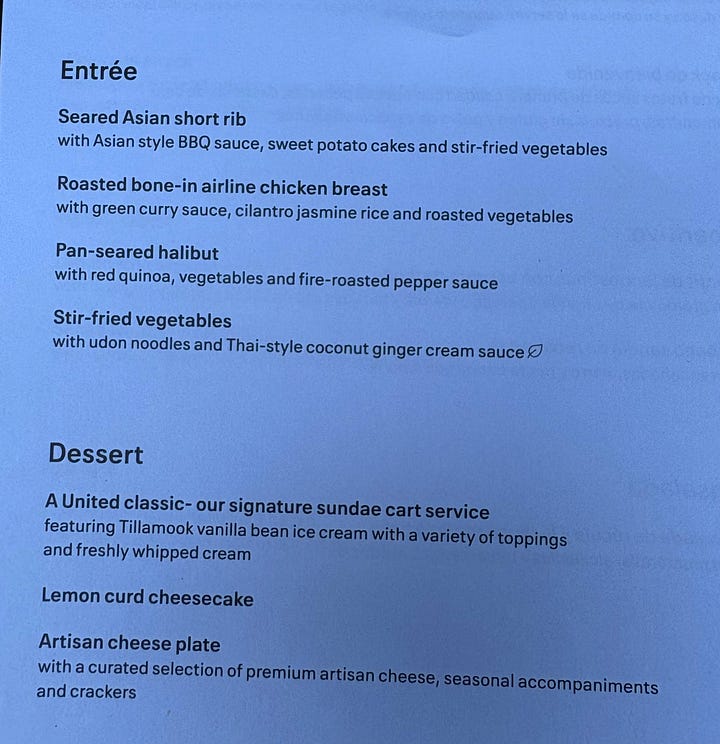
It turns out that “airline chicken” is a chicken breast with the first wing joint (known as the “drumette”) still attached. I believe the name arises from someone thinking the shape of the cut resembles an airplane. I’m not sure it really does. But it was a decent meal. Although it was nothing exceptional, it was a cut above what I would normally expect from chicken served by an airline.
When I placed my order, I remarked to the flight attendant that I was curious what “airline chicken” would turn out to be. It occurred to me afterwards that she might not have known or remembered that my chosen dish was actually referred to on the United printed menu as “airline chicken,” and may have thought I was simply curious about what chicken on an airplane would be like. Which would be an odd curiosity, to say the least, given that chicken is such a staple of airline catering. Oh well.
Flight notes (2): Getting home on Aerolíneas Argentinas
I flew back to the U.S. on the evening of race day. After the race, I had some time to kill between checking out of the hotel and heading to the airport. But I didn’t have the energy to do anything very ambitious. I don’t usually eat much red meat these days, but felt that while in Argentina — the land of steak — I should make an exception. So I went to a packed neighborhood restaurant not far from my hotel, where they managed to squeeze me in. And I was glad I did. The steak — accompanied by some excellent local Malbec — hit the spot for a late, post-race Sunday lunch.
There are surprisingly few flights between the U.S. and Argentina. There are no flights whatsoever from the West Coast. Nor are there any to Brazil, for that matter. It’s odd. And the only city in the U.S. served by Aerolíneas Argentinas — the country’s national airline — is Miami. They share that route with American. I decided that afternoon to go back via Miami. It wasn’t the quickest route back to Southern California, but it would give me a chance to spend several hours with my son, a senior at the University of Miami.
Although my wife’s airline has excellent reciprocal flight benefits with American — including standby Business Class at no extra charge — and as fond as I am of AA (on which I have over two million miles as a revenue passenger), I decided to go with Aerolíneas for the flight to Miami. The chances of getting to the front on American seemed slim, and the back was looking pretty packed. Aerolíneas, by contrast, was showing over 50 empty seats at the back. And I like trying out different airlines.
Argentina — as well as being the land of steaks — can at times be a land of strikes. There was an on-and-off air traffic control strike taking place that week, resulting in delays and cancellations. But my flight wasn’t too badly affected.
If I were the sort of reviewer who goes down an objective check-list of airline amenities, I probably wouldn’t give Aerolíneas an especially high score. The overall experience did seem like a flight from 20 years ago (although that’s not necessarily a bad thing). It’s no Qatar. But I rate flights on a more subjective, holistic basis. My flight — on a distinctly well-worn A330 — was overall very pleasant. I had a row of two to myself on the window in economy and slept most of the way until we were nearing Cuba. The service by a very seasoned cabin crew was down-to-earth and professional, not that I needed much of it on this redeye.
It’s one of the airlines where you don’t standby at the gate, and you can’t go through security until you’ve been accepted on the flight. When I went to check-in about three hours before departure, they weren’t ready to clear me, but did so when I returned about 45 minutes later. That meant I had time to go to the Amex Centurion Lounge. I was a bit surprised there was an Amex lounge in Buenos Aires. This provided me a relatively rare opportunity to use one. It’s usually hard to use Amex lounges when traveling standby as they insist on boarding passes showing a confirmed seat — and many airlines will only give you one when there is virtually no time left for a lounge visit, even if the number of open seats makes it more or less certain you’ll get on.
The Amex Lounge was quite crowded but pretty good. Most reviews suggested it was better than the Priority Pass ones in the Buenos Aires airport, so I decided to hang out there rather than go lounge hopping — even when an hour-long delay gave me some extra time (and resisting the nagging traveler feeling in me that I ought to find out about the others for myself). But as grateful as I was to have a decent lounge, I still find that non-airline lounges miss something of the aviation vibe you get with one that’s operated by an airline. That was all the more so as there were no windows looking out on the runways or ramp as far as I could see (not that I would have seen much at that time of night).
My son and I enjoyed a Cuban breakfast near Coral Gables after I landed in Miami. We then shared a pitcher of Bud Light sitting outside the UM campus bar in hot August noontime temperatures before I took the metro back to MIA to continue my journey home. My day job required my presence, or I might have stayed a bit longer.
Buenos Aires half marathon sum-up
For: Great, generally well-organized, race in a very cool city; fantastic, pretty flat course; Southern Hemisphere winter temperatures in August. Against: Not much, but post-race crowd management could be improved; some risk of poor weather at that time of year. Sum-up: A really fantastic fly-run experience. ✈️ 🏃
If you’ve stumbled across this post, please consider subscribing to this blog using the button below. It covers the intersection of running, travel, and aviation, and includes race reviews from around the world. Subscribing costs nothing — and never will — but supports the site. You’ll get an email every month or two with new posts. Please also share this post with anyone you think might be interested.

